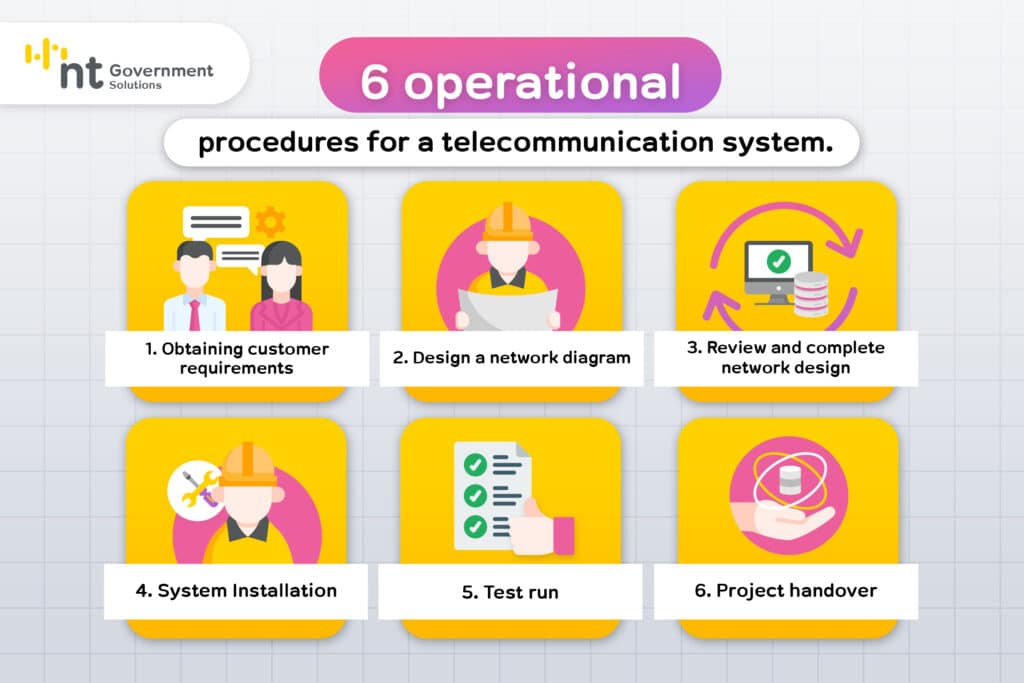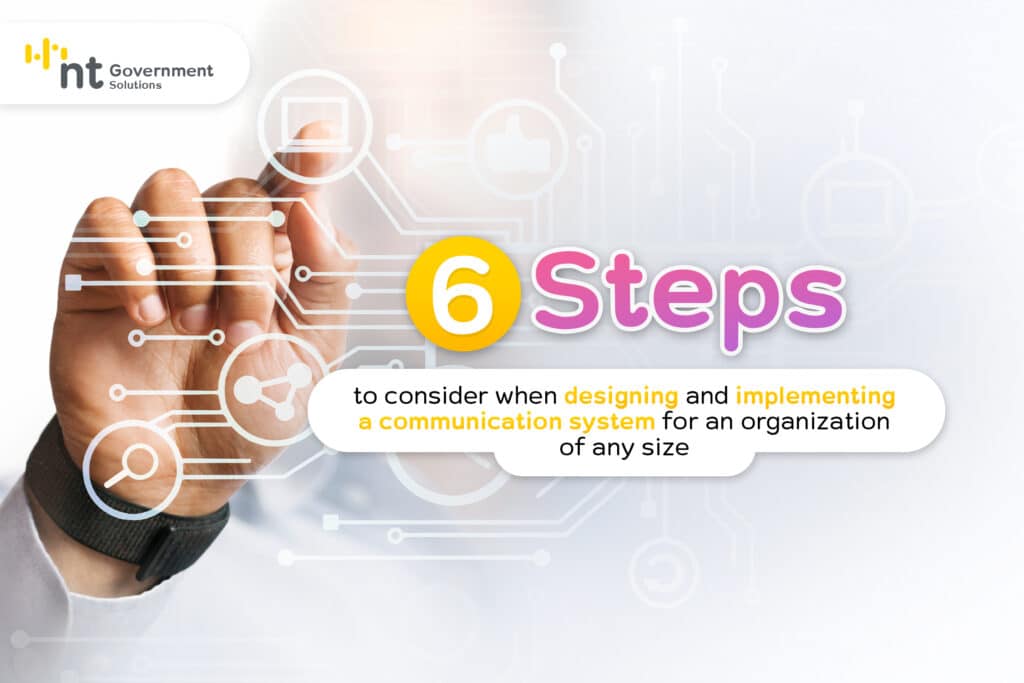With respect to telecommunications systems, several factors contribute to the success and efficiency of system implementation. One of these factors is the entity responsible for implementing the system. The agency responsible for installing telecommunications systems must be equipped in many ways. These include specialists in various fields, sufficient personnel, modern technologies, a solid and careful plan, and a systematic workflow. After all, a telecommunication system is detailed, complex and meets a wide range of requirements. Data is stored securely, and we can implement additional solutions or approaches that take full advantage of the system.

For works that requires special skills and expertise, NT has the following 6 operational procedures for a telecommunication system installation for maximum work efficiency [1]
1. Obtaining customer requirements: This is the first step to find out the customer’s needs or reason for using the telecommunication system. In addition, the budget, the requirements and limitations of the system that the customers are currently using, and the duration of the work must be considered. During the site visit, survey the sites to be installed in various environments to gather information for later use in the system design.
2. Design a network diagram: Once the team has gathered all the information, the next step is to use the information to design the operating system by a team of experienced engineers. The systems should be designed according to the customer’s needs. The installation equipment and system design should be able to connect to the original system and provide appropriate solutions.
3. Review and complete the network design: the next step is to review and revise the telecommunication system implementation proposals. This may include, for example, equipment installation design and other services to fully meet the customer’s needs. All plans are then presented to the customer. If anything needs to be changed in the system design or proposals, it can be done at this time.
4. System Installation: After system planning and any other adjustments, we move on to system installation. This step is performed by professional and experienced installation staff, which includes experienced engineers. These personnel will closely supervise the work so that customers can be sure that the system will be installed as planned. If there are any problems, they can be fixed in time to optimize the system.
5. Test run: After the system installation is completed, a test run must be performed before the system is publicly activated. This test will check various situations, including checking the backup system (if any), to investigate and fix any potential problems before the system is publicly activated. This also includes further customization of the system to meet the customer’s needs.
6. Project handover: the final step is handing over the completed installed system to the customer and training their staff on how to use the system. This enables them to understand how the system works and to use it smoothly and continuously. Until the end of the contract period, NT supports and maintains the systems and even provides continuous assistance and consulting.

Examples of previous telecommunication installations
To help our customers learn more about the process of installing telecommunications systems, NT would like to explain one of our many system installations, which is a digital infrastructure network for King Power International Co, Ltd. within the international departure terminal at Suvarnabhumi Airport. The workflow is as follows:
1. NT received a document that listed the client’s requirements and needs along with various conditions from the client.
2. As part of the engineering process, NT conducted a site visit to the location where the system was to be installed to plan and properly identify the operational procedures. This is to ensure maximum safety and minimize potential problems that could occur in the future.
3. NT designed the system, reviewed proposals, presented work, layouts, and equipment installation to the client, and customized the work to meet the client’s needs.
4. NT installed the system according to the company’s plan and regulations.
5. NT tested the system with the company after the system installation was completed to ensure project delivery.
6. NT prepared the project handover documents with all details to the company.
The following are the main solutions presented by NT King Power International Co., Ltd:
1. NT has installed fiber optic cable for all stores within the international departure terminal to provide high-speed “FTTx” Internet service, and has provided MPLS VPN and IP telephone services at the request of the stores and the company. NT also offers other third-party providers the opportunity to lease the company’s fiber optic network to provide thevariety of services to shops within the terminal, including a backup circuit service that is available and free of charge.
2. Shops within the project received fixed IP-Phone service.
3. High-speed digital leased line service: This is a private communications service for the transmission of audio and visual data between two sites on the data communications network of the respective organization. Data is transmitted via a circuit switch that relies on the DDN/SDH/DWDM network. This makes the circuit highly secure and provides a fixed speed for data transmission according to the bandwidth used. This is because the data is not shared with other lines. Therefore, there is no data congestion. Currently, the services are available with speeds ranging from 9.6 Kbps to 100 Gbps, which can support different types of interfaces such as FE, GE, TE, 100GE, STM -1-64, 10GbE, 40GbE or 16G FC.
• The network system is highly secure and can manage the QoS (Quality of Service) system and guarantee the quality of QoS (Quality of Service) service.
• The core backbone is a dual ring SDH network that provides a full backup route to the main network.
• The network system is designed to adequately support customers’ services. A traffic management system helps monitor system usage and retrieve key data for using in system expansion in the future.

Furthermore, NT provides the following system administration, problem solving service to King Power International Co., Ltd. as follows:
1. NT has assembled a team with expertise and experience to review and maintain the communication system and provide various services to the company 24/7, as presented to the company.
2. NT has assembled a communications team to resolve signal issues, stationed at each of the key service points for the company. This ensures that the system remains as stable and efficient as possible.
3. NT always monitors for a notification that there is a problem with the system, except for force majeure such as natural disasters or third-party incidents, etc. The communication system will be repaired as soon as possible so that normal operation can be resumed.
The constant determination and development of NT will help to ensure that telecommunications technology fully and efficiently meets the needs of customers. Interested organizations or individuals can contact NT for further enquiries about our services or a free expert consultation via the Facebook page: : NT shop กรุงเทพและปริมณฑล or through the website https://nt-metro-service.com


